Infrastructure • Signalling • ERTMS-ETCS
Note: For educational purpose only. This page is meant purely as a documentation tool and has no legal effect. It is not a substitute for the official page of the operating company, manufacturer or official institutions. It cannot be used for staff training, which is the responsibility of approved institutions and companies.
👉 (Version française disponible)
In brief
ETCS (European Train Control System) is a component of ERTMS (European Rail Traffic Management System), which is a system of safety and control for railways. ETCS is a signaling and train control system that includes automatic train protection, while ERTMS integrates ETCS with GSM-R (Global System for Mobile communications for Railways) and operating rules to create a unified railway management system across Europe.
The goal of ERTMS/ETCS is to replace the numerous national train control and command systems in Europe to ensure interoperability of trains across different countries. This system allows trains to cross international borders without the need for changing locomotives or systems, thus optimizing transit times and enhancing safety1. It’s being progressively implemented on high-speed lines and throughout the conventional network in Europe.
The European Rail Traffic Management System (ERTMS) is a major industrial project developed by eight UNIFE (Association of the European Rail Industry) members to enhance cross-border interoperability and signaling systems on railways throughout Europe. ERTMS consists of two main components: the European Train Control System (ETCS) and the Global System for Mobile Communications-Railway (GSM-R). Here are the core principles of ERTMS in detail:
Interoperability
ERTMS ensures that trains can travel seamlessly across borders within Europe. This involves standardizing signaling and control systems so that different national rail systems can work together without requiring extensive modifications to rolling stock or infrastructure.
Safety
ERTMS aims to significantly improve the safety of rail transport. This is achieved by providing continuous and automatic control of trains, ensuring they operate within safe speed limits and adhere to signals, thereby reducing the risk of collisions and derailments.
Capacity
By implementing more efficient signaling and control systems, ERTMS can increase the capacity of existing rail networks. It allows trains to run closer together safely, thus maximizing the use of available infrastructure and potentially reducing the need for costly expansions.
Performance
ERTMS enhances the performance of the railway network by improving punctuality and reliability. Advanced communication and control systems enable real-time adjustments to train operations, which can help minimize delays and optimize traffic flow.
Cost Efficiency
Standardizing train control and signaling systems across Europe can lead to significant cost savings in terms of both infrastructure and rolling stock maintenance. It reduces the need for multiple national systems and simplifies the design and production of equipment.
Sustainability
ERTMS contributes to environmental sustainability by making rail transport more efficient and attractive compared to other modes of transport, such as road or air. This can lead to a reduction in greenhouse gas emissions and other pollutants.
Detailed components of ERTMS
The ETCS system is above all a way of transmitting data from the ground to the train. Unlike other mobile devices (aircraft, ships), trains do not communicate with each other. So there is no satellite or radar link. For the railways, voice and data transmission can only take place via balises in the track or by specific GSM-R radio (soon FRMCS). The choice of one or other transmission mode determines an “ETCS level”, as described below.
Trackside components:
The choice of one or other level implies a choice of transmission. There are two assets available:
- balises placed (by groups of 2 balises) in the centre of the track. These balises deliver different messages that can only be read when the train passes over them. With the balises, you only receive information occasionally. If there are no balises, no information is available;
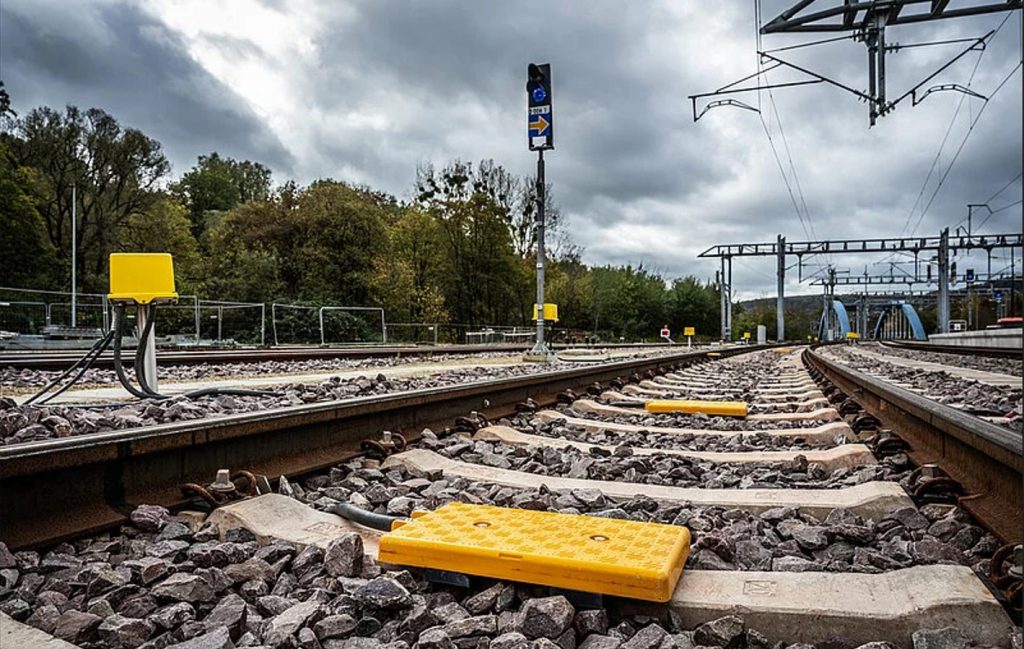
- GSM-R radio, which will migrate to a new standard called FRMCS. GSM-R delivers the same messages as beacons, but unlike beacons, with GSM-R the information is available anywhere and at any time. GSM-R / FRMCS transmission requires however the regular installation of GSM-R masts every X kilometres to ensure good transmission coverage.
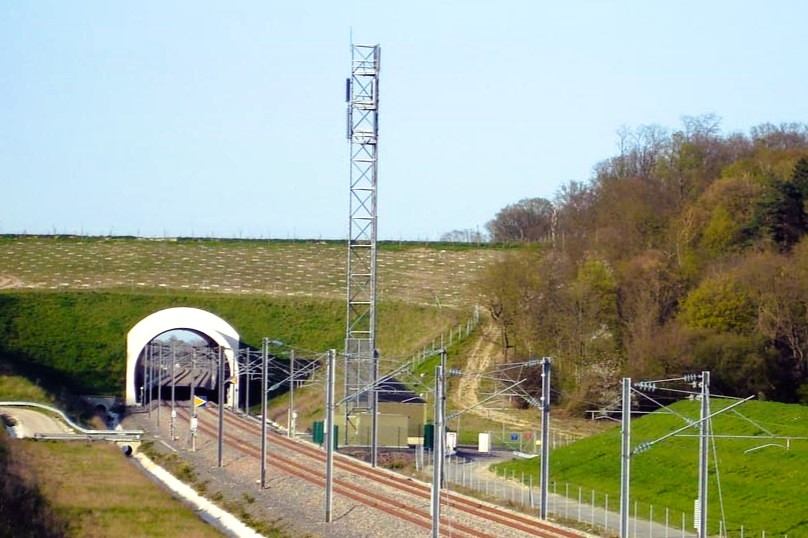
On-board equipment
All trains running under ETCS must have on board the three essential components without which there will be no signal reception and any possibilities of message reading:
- The BTM (Balise Transmission Module) is a module inside the ETCS onboard equipment for intermittent transmission from track to train, which processes signals received from the onboard antenna and retrieves data messages from a Eurobalise.
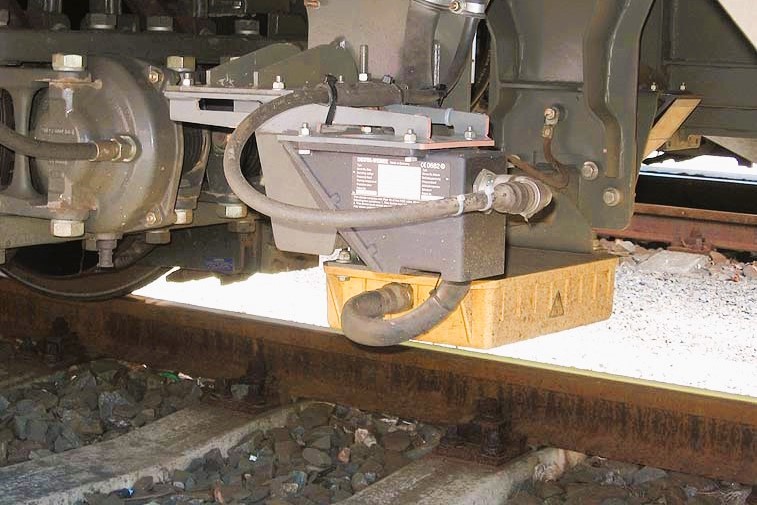
- The heart of the on-board system is managed by a safety computer: the European Vital Computer (EVC). It receives all the messages transmitted, whether by balises or GSM-R. In the case of GSM-R, a small antenna is required on the roof of the train. This is smaller than the antenna under the train that receives messages from the balises. The EVC is responsible for translating all the messages and transmitting them in movement orders to the driver. The EVC also monitors the train’s speed. This is where there is a big difference between trains that are equipped with the EVC and those that are not.

- The ETCS DMI screen is the interface between the driver and the ERTMS/ETCS system. It gives the essential instructions that the driver must follow (speed limits, planning zone, ETCS level, mode, etc.) and enables information to be entered (driver identity, train data, etc.) and driver actions to be triggered (selection of driving mode, confirmation, acknowledgement). The DMI is the key element that makes all locomotives fitted with it interoperable. Its design is standardised, regardless of the company that sells and installs it. The screen is the same whether you are in Finland, Austria, the UK or Portugal.
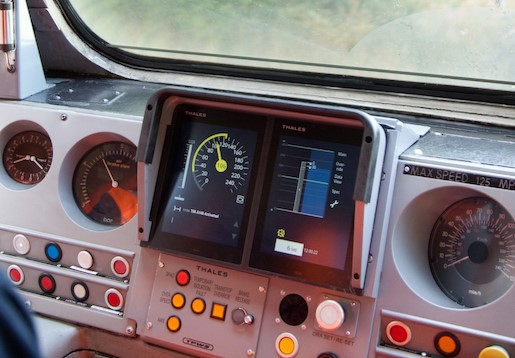
Four levels
ETCS is a standard for train control and command systems. Currently, there are four ERTMS/ETCS levels (L0, LSTM, L1 and L2). The different ERTMS/ETCS application levels are a way to express the possible operating relationships between track and train.
First, there are two existing levels: Level 0, which applies to trains equipped with ETCS running on non-equipped lines; and Level STM (Specific Transmission Module), which is meant for trains equipped with ETCS running on tracks where the legacy national system (i.e. Class B system) needs to be operated. With regard to the STM level, ETCS acts as an interface between the driver and the national ATP (Automatic Train Protection).
Some networks use both balises and GSM-R for limited functions. This is what Infrabel has done in Belgium: by installing GSM-R and balises for its national TBL1+ signalling system (which is an STM), Infrabel was already preparing for the migration to ETCS.
Beyond the two first levels, these are two true ETCS levels:
- ETCS Level 1: Uses fixed signaling with intermittent train control. It involves the use of balises to transmit data to the train. The main benefits brought by ERTMS/ETCS Level 1 are interoperability (between suppliers and countries) and safety, since the train will automatically brake if exceeding the maximum speed allowed under the movement authority;
- Advantage: safer system than the STM level;
- Disadvantage: you only receive information when you pass over a balise. No balise, no information…
-
ETCS Level 2: Offers continuous communication between the train and the radio block center (RBC) via GSM-R (soon FRMCS). It eliminates the need for trackside signals, providing real-time data and allowing for more efficient train operation. The implementation of L2 (incl. former L3) enables increasing line capacity by enabling higher operational speeds and offering reduced headways resulting in improved passenger experience.
- Advantage: the safest system because the train’s speed is constantly monitored, second by second, thanks to continuous GSM-R transmission, which is not the case with level 1 (intermittent train control).
- Disadvantage: A more expensive system for operators, which means that all the rolling stock must be equipped with ETCS on-board equipment. If this is not the case, the signals have to be left at the trackside, which is a duplication and therefore a source of waste for infrastructure manager.
Former ERTMS/ETCS Level 3 has been merged into ERTMS/ETCS Level 2 with the CCS TSI 2023. Therefore, it is not used anymore as a differentiator for specific functionalities, like fixed virtual block / moving block with assurance of train integrity and location within the ERTMS/ETCS solution.
Summary of the full concept
In blue, GSM-R is transmitted to the EVC on board the train via a small antenna on the roof of the train. ETCS Level 2
The EVC receives information from the GSM-R (blue) or the balises (red), translates the messages and sends movement authorisation to the DMI for the driver (yellow).
The antenna under the train picks up the message from the balises (in red) as it passes over them. ETCS Level 1
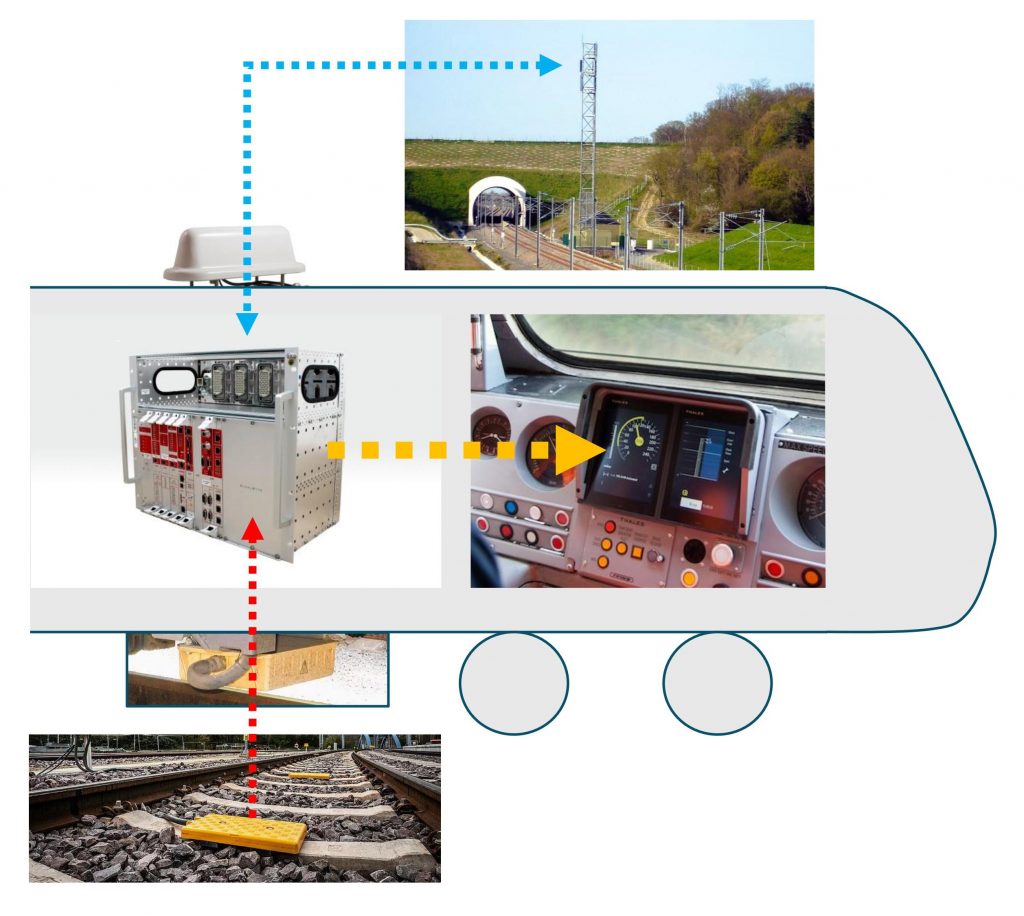
🟧
[TOP]
Infrastructure • Signalling • Lexical
